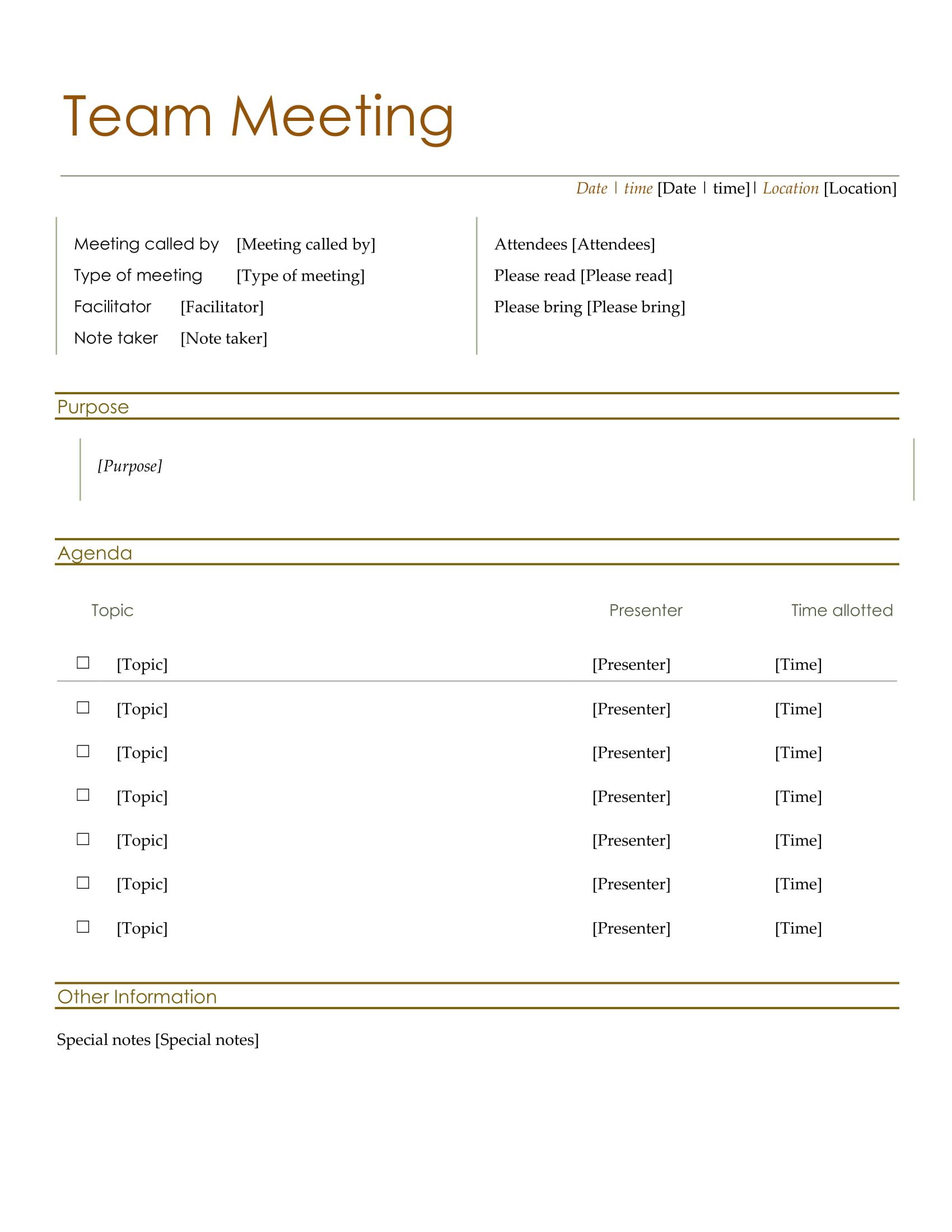How to Write an Effective Team Meeting Agenda
The first place to look when trying to run more effective meetings is the agenda. An agenda sets the tone and the direction of a meeting while also laying out clear expectations for what the outcome of the meeting should be.

Are you looking to improve your meetings? If so, assessing why your meetings aren't always going as planned and/or not delivering the value you believe they should, is an essential step to improving. The first place to look when trying to run more effective meetings is the agenda, or in some cases, a lack thereof. An agenda sets the tone and the direction of a meeting while also laying out clear expectations for what the outcome of the meeting should be. An effective meeting agenda should contain the purpose of the meeting, the main topics of the meeting, time blocks to control the flow of the meeting, and a list of decisions that should be made by the end of the meeting. In this post, I will walk through the core components of meeting agendas and explain how to add each element to all of your future agendas.
Define the Meeting's Purpose
Before scheduling a meeting, it is critical to define why you are having the meeting in the first place. If it is unclear what the meeting will achieve or if the contributions of others will be of use, a quick email check-in may suffice. It is important to remember that scheduling a meeting can have hidden costs. Calling a meeting that lacks a clear purpose won't bring in any new value to your team and will only cost you money and time.
When determining why you are having a meeting, frame it in terms of what you plan to achieve. Walking into a meeting with a clear objective and expected outcomes will keep your meetings focused and purpose-driven. With a purpose set, answering the following key questions about your meeting will become far more straightforward.
- What do you plan on achieving in this meeting?
- Who must attend this meeting for it to reach its goal?
- What discussion topics should be on this meeting agenda?
By starting with your meeting purpose, you clarify expectations for all of the meeting participants. A rock-solid purpose for your meeting will get your entire team on the same page and is the first step in a great meeting agenda. With our purpose defined, we can start to create the individual agenda items.
Remote meetings
Today's meetings are shifting to being primarily online and remote team meetings are quickly becoming the norm. With everyone dispersed around the globe, clear meeting objectives are more imperative than ever. To really have an efficient meeting in a remote workplace, a robust meeting objective is an integral part of this equation. Time spent outlining the meeting's purpose will save many hours discussing with team members before the meeting has begun.
Creating Agenda Items
When most people think of an agenda, they think of the list of topics that will be discussed during the meeting. Although true, this isn't the complete picture. To supercharge your meeting agenda items, don't simply write down a list of discussion points. Instead, write agenda items with three parts: the subject of the agenda item, a time allotment to keep the discussion from going on too long, and all required decisions that need to be made by the end of the agenda item or end of the meeting.
Topic/Subject of an Agenda Item
The topic or subject of each agenda item is essential to communicating what needs to be discussed and keeping the conversation focused. The topic should be clear and to the point, such that anyone who is attending the meeting can glance at the item and understand what the discussion will be about. Additionally, an agenda is a record of what was discussed in a meeting and writing clear and concise topics for yourself later is critical.
The topic of each agenda item will be the starting place for the meeting minutes. The minute taker on the team needs clear agenda topics to write the most complete and relevant minutes for the meeting. The quality of your meeting agenda topics can have a large downstream effect that will carry through your team's projects.
Allotting Time to each Agenda Item
We have all been in a meeting with six or so agenda items where the discussion gets stuck on the second item and only moves on five minutes before the meeting is scheduled to end. Setting a time allotment for each agenda item keeps the meeting running at a steady pace. Sometimes discussions around a single agenda item can go on for hours, but oftentimes the central arguments are discussed and acknowledged within the first 15 minutes of discussion. With a time limit, participants will focus on the pivotal points that could change the direction of a project and not on smaller, unimportant details of contention. When setting a time limit for your agenda item, give a realistic amount of time to each point in case an interesting point does arise. And if not, shorter meetings are appreciated by everyone!
Required Decisions for each Agenda Item
When looking at why organizations have meetings in the first place, they are used to organize people and resources towards common goals. The desired results from a meeting are that decisions about the team are made and clear action items are created for everyone to execute their goals. Embedding the decisions needed right into your agenda expresses what the expected result of that agenda item is. Also, mention these decisions before starting the discussion to alert your team that a decision must be made. Placing the required decisions on the agenda notifies the key stakeholders to provide input and feedback on parts of the project that are important to them.
Getting Feedback Before the Meeting
Before your meeting begins, reach out to the other meeting participants with your agenda to very briefly discuss what should be added or removed. This will help improve your meetings in two major ways. First, it will help you identify issues or missing information before this is noticed during the meeting. Second, by having others critique your agenda, your team provides a feedback loop that will help you craft more efficient and effective meeting agendas in the future.
When gathering feedback on your agenda, keep it focused on the purpose of the meeting. Others may want to add new agenda items to the list that are not relevant to this specific meeting. As the person running and/or moderating the meeting, it is your job to choose what gets accomplished during this meeting and see it through.
Feedback shouldn't be limited to just before a meeting. Some things only present themselves as problems when the meeting is underway and asking for feedback after the meeting can give you insight into why your agenda wasn't perfect and what you can do to improve your future agendas.
On top of improving your agenda, seeking feedback also provides an inclusive environment for your team. Many people report being unengaged in their meetings and small acts can make a difference in participation. Making an active effort to make meetings an equal playing field can help your team reap the rewards of each other's best ideas.
Try creating a simple routine like a 5 minute feedback process to organize and clarify your meeting agendas.
Meeting Agenda Template:
So you've learned how to write an amazing agenda, and you want to bring these ideas to your next meeting. Either you can make your own meeting agenda template or look for a template online. Lucky for you, we have a template right above for you to get started with. This template has space for your meeting purpose, agenda items, time slots, and decisions. This example meeting agenda template will allow you to hit the ground running in your next meeting. It is also easily editable so you can tailor it to your individual needs.

Additionally, you can use tools like Knowtworthy which keep track of all of your team's meeting documents and allows you to share your meeting's agenda in real-time with all of your meeting attendees.
Tailoring the Meeting Agenda to the Meeting Type
Depending on the type of meeting you are organizing, the structure of the agenda can be adapted to the meeting's needs. Board meetings and other formal meetings need rigid time blocks and static agenda items because in a board meeting the goal is to update the board on the company's latest developments and make decisions about the business. But, your meetings are most likely not board meetings. Within your team meetings, meetings should be more flexible to match your team's goals. Setting aside time to openly discuss new ideas is necessary when the team needs to brainstorm its latest solution. To get the most out of an agenda, remember to bend it to your needs and goals.
Conclusion
A meeting agenda isn't just a list of items to discuss during a meeting, but a developed purpose for the meeting. The purpose guides how the rest of the agenda should be crafted and what should be addressed. When building your agenda items, don't just make a list of topics to talk about, but add a time allotment to keep the meeting flowing and decisions that your team is expected to produce by the end of the meeting.
Before your meeting, reach out to your team to get feedback on your agenda to produce better agendas and make you improve your meetings too. Additionally, roping in the rest of the team will keep them engaged and strengthen your team dynamic as you all see your meeting productivity skyrocket. Also, get feedback at the end of the meeting because some problems aren't detectable until you are already at the meeting table.
Finally, stay flexible! Your meeting agenda needs to work for you. So don't be afraid to change its structure to fit those needs.
Now it's time to have truly productive meetings!
